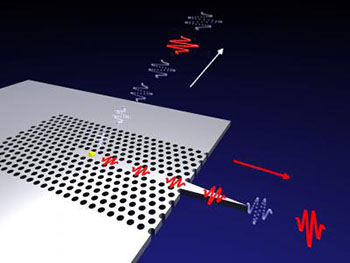
In a “single-photon cannon,” a quantum dot (yellow) embedded in a photonic crystal emits single photons, 98.4 percent of which flow preferentially in the direction of the hole-free waveguide (red arrow direction), with only 1.6 percent of photons lost (white arrow). (Illustration: Marta Arcari, Niels Bohr Institute)
Photonic circuits promise huge breakthroughs in quantum communications and information. But realizing systems such as single-photon switches, diodes and transistors requires a reliable source of individual photons, and the ability to control their propagation in the circuit. A group of scientists in Denmark and Korea now report achieving such a feat, by demonstrating that a quantum dot coupled to a photonic crystal waveguide can pump individual photons into the desired waveguide mode with a probability approaching 100 percent (Phys. Rev. Lett., doi: 10.1103/PhysRevLett.113.093603).
The nub of the problem at hand, according to Peter Lodahl, head of the quantum photonics research group at the University of Copenhagen’s Niels Bohr Institute, Denmark, is to emit single photons—bosons—from a fermionic system. To do so, Lodahl’s team, along with scientists from the Korea Institute of Science and Technology, embedded a quantum dot within a ten-µm-wide, 160-nm-thick photonic crystal, created by etching holes in a semiconducting material, with a hole-free channel acting as a single waveguide to capture light emissions from the dot.
They then shone laser light on the dot, which excited the electrons in the system and caused them to emit single photons, with 98.4 percent success, into the crystal waveguide. Effectively, according to the scientists, the quantum dot acts as a “1-D artificial atom” in a “nearly ideal photon-matter interface,” firing single photons, cannon-like, into the waveguide channel.
The research group suggests that the new technology will open the door for realizing transistors and logic gates for deterministic quantum information processing—and, more generally, could emerge as an essential building block for future quantum technologies.
